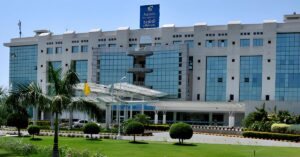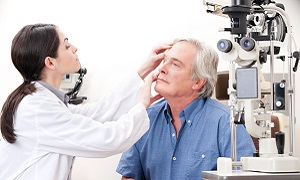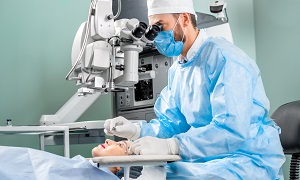Best Doctors in India for Diabetic Retinopathy Treatment
Best Hospitals in India for Diabetic Retinopathy Treatment
- City: Mumbai, India
Hospital Highlights:
- Fortis Hiranandani hospital was established in 2007.
- The hospital is an advanced tertiary care, multi-specialty hospital equipped with 149 beds.
- The hospital is equipped with a super ICU to provide emergency medical care to critically ill patients.
- The hospital is NABH accredited.
- The critical care facility in the hospital is augmented with the state-of-the-art facilities that facilitate speedier diagnosis and efficient monitoring.
- The hospital provides specialty medical services in cardiology, orthopedic science, pediatric science, neurology, diabetic care, urology, nephrology, ENT, obstetrics, gynecology, cosmetic surgery, bariatric surgery, neuro and spine care.
- City: Gurugram, India
Hospital Highlights:
- W Pratiksha Hospital, Gurugram, is one of the best hospitals in the NCR region. It is also a top hospital in India for IVF. Since its inception, the hospital has performed over 5500 successful IVFs. The hospital also specializes in gynecology.
- With over 20 years of experience in providing quality healthcare, the hospital is known as one of the most trusted and valued health providers in India.
- Equipped with world-class medical facilities and advanced technology, the hospital’s doctors and clinicians also have a track record of delivering excellent results. The hospital is also known for focusing on preventive well-being as much as on curative treatment.
- The hospital has earned the trust of its patients, by providing the best available treatments at affordable costs.
- City: Gurugram, India
Hospital Highlights:
- Paras hospital was established in 2006 and is the 250 bedded flagship hospital of Paras Healthcare.
- The is supported by a team of doctors of international and national repute.
- The hospital is NABH accredited and also the first hospital in the region to have a NABL accredited laboratory.
- The hospital provides specialty medical services in around 55 departments including Neurosciences, Joint Replacement, Mother & Child Care, Minimal Invasive Surgery, Gynecology and Obstetrics, Ophthalmology, Dermatology, Endocrinology, Rheumatology, Cosmetic and Plastic surgery.
- The hospital is equipped with state-of-the-art technologies.
- City: Kolkata, India
Hospital Highlights:
- Fortis Hospital, Anandapur, Kolkata is a world-class super-speciality equipped with the latest technologies in the medical world.
- The hospital is NABH accredited.
- This state-of-the-art facility specializes in cardiology and cardiac surgery, urology, nephrology, neurosciences, orthopaedics, digestive care, emergency care and critical care.
- The hospital, governed by integrated Building Management System (IBMS), has a pneumatic chute system, for quick vertical and horizontal transportation between floors, facilitating speedy transfer of patient specimens, documents, reports, and medicines to the concerned departments.
- The hospital also has a nephrology department with over 28 advanced dialysis units.
- City: Mumbai, India
Hospital Highlights:
- SL Raheja hospital is a 140-bed multi-specialty tertiary care hospital that is being managed by Fortis Healthcare Ltd.
- The hospital is a benchmark in healthcare and medical facilities in the neighborhood of Mahim & the western suburbs.
- L.Raheja Hospital, Mahim has one of the most effective ICU and Casualty care services.
- The hospital provides specialty medical services in Cardiology, Oncology, Neurology, Orthopedics, Mother & Child Care, and in Diabetes.
- City: Mumbai, India
Hospital Highlights:
- Wockhardt Hospitals were established in the year 1973, originally called First Hospitals and Heart Institute.
- Wockhardt Hospitals are super specialty health care networks in India, nurtured by Wockhardt Ltd, India’s 5th largest Pharmaceutical and Healthcare company.
- Wockhardt Hospitals is associated with Partners Harvard Medical International, an international arm of Harvard Medical School, USA.
- Wockhardt Heart Hospital performed India’s first endoscopic heart surgery.
- The hospital has a state-of-the-art infrastructure equipped with the latest technologies and modern equipment.
- It has special Centers of Excellence dedicated to the major specialties to provide hassle-free and high-quality clinical care.
- City: Gurugram, India
Hospital Highlights:
- The CK Birla Hospital in Gurugram is a NABH-accredited multi-specialty hospital.
- The hospital strives to increase the quality of healthcare by focusing on UK NHS nurse and midwife training requirements. Policies and practices derived from the National Institute for Health and Treatment Excellence (NICE) recommendations in the United Kingdom ensuring that a strong focus on safety, high-quality clinical care, and sanitation is maintained.
- The hospital’s cutting-edge technology and facilities allow for real-time communication and seamless collaboration among caregivers, ensuring accuracy and the best possible results. Those with foreign experience and accreditations make up part of the hospital’s team of clinicians.
- City: Ahmedabad
Hospital Highlights:
- As a member of the Apollo Hospitals Group, Apollo Hospitals International Limited, Ahmedabad is one of the most popular and sought-after medical facilities in Gujarat.
- Through its 6 Centres of Excellence and various affiliated branches, which cover all specialties and subspecialties, the hospital provides the most advanced clinical services.
- Since its inception in 2003, the hospital has been providing each patient with the most up-to-date medical equipment and state-of-the-art technology.
- With more than 150 successful organ transplants, including liver and renal transplants, the facility has been able to build a strong and extensive organ transplant program.
- In addition to performing 600 surgeries and caring for over 1800 patients on an IP basis, the hospital sees more than 18,000 patients on average in the outpatient department.
- With one of the biggest cardiology teams in the area, the hospital provides state-of-the-art regional care treatment in Cardiac Sciences.
- Additionally, the hospital offers a broad range of Neuro Interventional techniques to help stroke patients recover more quickly.
- City: Noida, India
Hospital Highlights:
- Jaypee Hospital is the flagship hospital of the Jaypee Group.
- This hospital has commissioned 525 beds in the first phase and has been planned and designed as a 1200 bedded multi-specialty facility.
- It holds the accreditation of the NABH and NABL.
- The hospital has state-of-the-art infrastructure equipped with the latest technologies and modern equipment like 64 Slice PET CT, Dual Head 6 Slice SPECT CT, Gamma Camera, and Da Vinci Robotic Surgery for comprehensive robotic surgical solutions.
- It has special Centers dedicated to the major specialties to provide hassle-free and high-quality clinical care.
- City: Mumbai, India
Hospital Highlights:
- Reliance Hospital is one of the best super-specialty care hospitals in Navi Mumbai.
- The main purpose of this hospital is to become a trustworthy place for the best health and hope for society. The hospital is well connected to the suburbs of Mumbai and Navi Mumbai.
- The hospital has various specialty departments, viz., Accident & Emergency, Anesthesiology, Dental Services, Dermatology, Diabetology, Dietetics Nutrition, Endocrinology, ENT, Gastroenterology, General Surgery, Gynaecology And Obstetrics, Hepato Pancreato Biliary Surgery, Infectious Disease, Internal Medicine, Interventional Radiology, Laboratory Medicine, Minimal Access Laparoscopic Surgery, Nephrology, Neurosciences, Opthalmology, Orthopaedics, Paediatrics, Pain Management Palliative Care, Physical Medicine Rehabilitation, Plastic And Reconstructive Surgery, Psychiatry, Pulmonary Medicine, Radiology, Rheumatology, Transplant, Urology Andrology, Vascular Surgery
DIABETIC RETINOPATHY
Diabetic retinopathy is a condition that occurs due to damage to the blood vessels of the retina in people suffering from diabetes. If you have type 1 or type 2 diabetes, and a long history of uncontrolled blood sugar levels, you might develop diabetic retinopathy.
Though the condition generally starts with a mild vision loss, eventually you might even lose your sight. Diabetic retinopathy is known to be the most common eye disease among people who suffer from diabetes.
Symptoms
Although you might not have any symptoms in the early stages of diabetic retinopathy, as the condition progresses, some of the symptoms might include:
- Blurred vision
- Fluctuating vision
- Floaters
- Dark or empty areas in your vision
- Impaired color vision
- Vision loss
This condition is known to generally affect both eyes. If you are suffering from diabetes, managing it carefully is one of the best ways to prevent loss of vision. Even if your vision seems fine, see your eye doctor once every year for an examination.
Pregnancy might also worsen diabetic retinopathy, and therefore if you are pregnant, additional eye exams might be recommended by your doctor.
If your vision changes suddenly or becomes blurry, spotty, or hazy, then contact your eye doctor right away.
Causes & risk factors
High levels of sugar in your blood over long periods can lead to diabetic retinopathy. The excess sugar causes damage to the blood vessels supplying your retina with blood. High blood pressure is a risk factor, as well, for retinopathy.
The retina is a layer of tissue in the back of your eye, which helps to change the images that the eye sees into nerve signals so that the brain can understand them. When the retina’s blood vessels undergo any damage, they can get blocked. This cuts off some of the blood supply of the retina. This loss of blood flow can even lead to other, weaker blood vessels to grow and these new blood vessels may leak and also create scar tissue which can lead to loss of vision.
The longer you suffer from diabetes, the higher are your chances of developing diabetic retinopathy. People who suffer from diabetes for over thirty years generally show signs of retinopathy. Managing your diabetes can generally slow the progression.
Although any person with diabetes is at risk of diabetic retinopathy, the risk becomes higher if the person:
- Has uncontrolled blood sugar levels
- Has high cholesterol
- Has high blood pressure
- Is suffering from diabetes for a very long time
- Is pregnant
- Smokes regularly
Diagnosis
Eye exam
- Scarring
- Leaking of the blood vessels
- Blocked blood vessels
- Changes to the lens
- Retinal detachment
- Damage to the nerve tissue
Fluorescein angiography test
They may also perform a fluorescein angiography test, which involves injecting a dye into your arm, which allows them to track how the blood flows in your eye. They will need to take pictures of the dye circulating inside your eye so that they are able to determine which vessels are blocked, leaking, or broken.
OCT exam
An OCT (optical coherence tomography) exam might be used as well. It uses light waves in order to produce images of the retina. These images let your doctor determine the thickness of your retina and let him/her known if any fluid has accumulated in it.
Treatment
For people suffering from early diabetic retinopathy, treatment options are limited. Your doctor might want to perform regular eye exams, in order to monitor the eye health just in case, treatment becomes necessary. An endocrinologist can also help you slow the progression of the condition by helping you manage your diabetes.
For people suffering from advanced diabetic retinopathy, the treatment options depend on the type and severity of the condition. Treatment can be of various types.
Photocoagulation surgery
Scatter photocoagulation
Scatter photocoagulation is a method that involves using a laser to burn hundreds of tiny holes in the eyes so that the risk of blindness is reduced.
Focal photocoagulation
Focal photocoagulation, meanwhile, involves using a laser to target a specific leaky vessel in the macula so that macular edema doesn’t worsen.
Vitrectomy
Vitrectomy is another method of treatment that involves removing scar tissue and cloudy fluid from the vitreous fluid of the eye.
Complications
If left untreated, diabetic retinopathy might lead to several complications.
When blood vessels bleed into the vitreous, the main jelly that fills the eye, this is called vitreous hemorrhage. The symptoms include floaters, in mild cases, but in severe cases, symptoms can include vision loss, as the blood in the vitreous blocks any light from entering the eye. If the retina remains undamaged, then the bleeding in the vitreous is able to resolve itself. In some cases, diabetic retinopathy might even cause a detached retina. This complication can happen if scar tissue pulls the retina away from the back of the eye.
The abnormal blood vessels which are associated with this condition stimulate the growth of scar tissue as well, which can pull the retina away from the back of the eye. This is known as retinal detachment. This can cause spots floating in your vision, flashes of light, or in some cases, severe vision loss.
In some cases, blood vessels might grow in the front part of your eye, and this might interfere with the normal flow of fluid out of the eye, causing pressure in the eye to build up. This is known as glaucoma. This pressure can damage the nerve carrying images from your eye to your optic nerves.
Diabetic retinopathy, glaucoma, or a combination of both can lead to you losing your vision completely.
Prevention
Diabetic retinopathy can’t be always prevented. However, regular eye examinations, as well as proper control of your blood sugar and blood pressure, as well as an early intervention for vision problems can help to prevent severe vision loss.
If you smoke or use any other kind of tobacco, quitting is the best way to prevent diabetic retinopathy. Ask your doctor if you need help in quitting.












